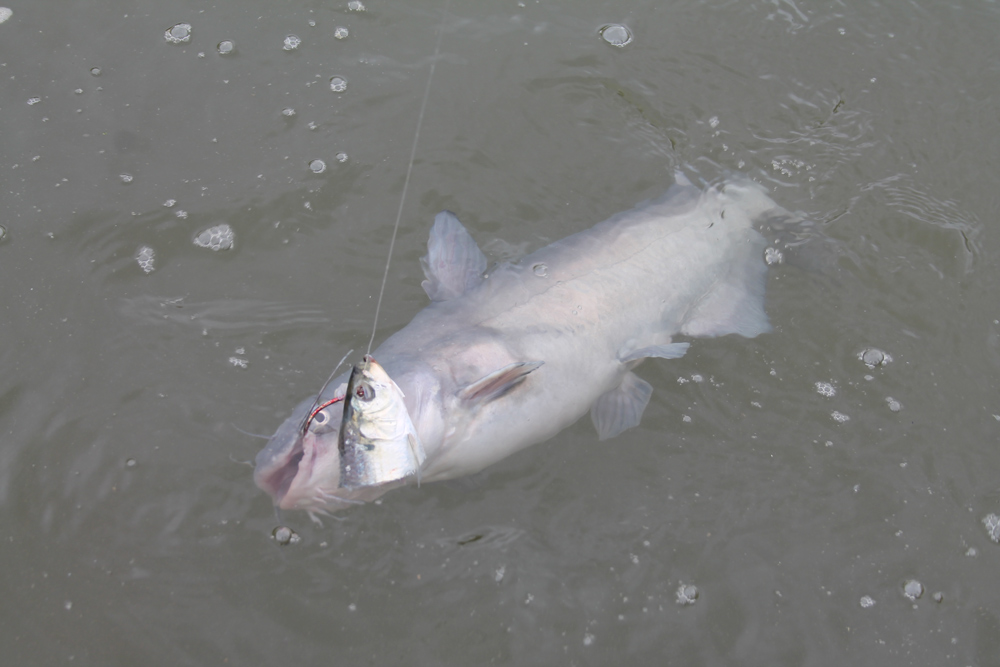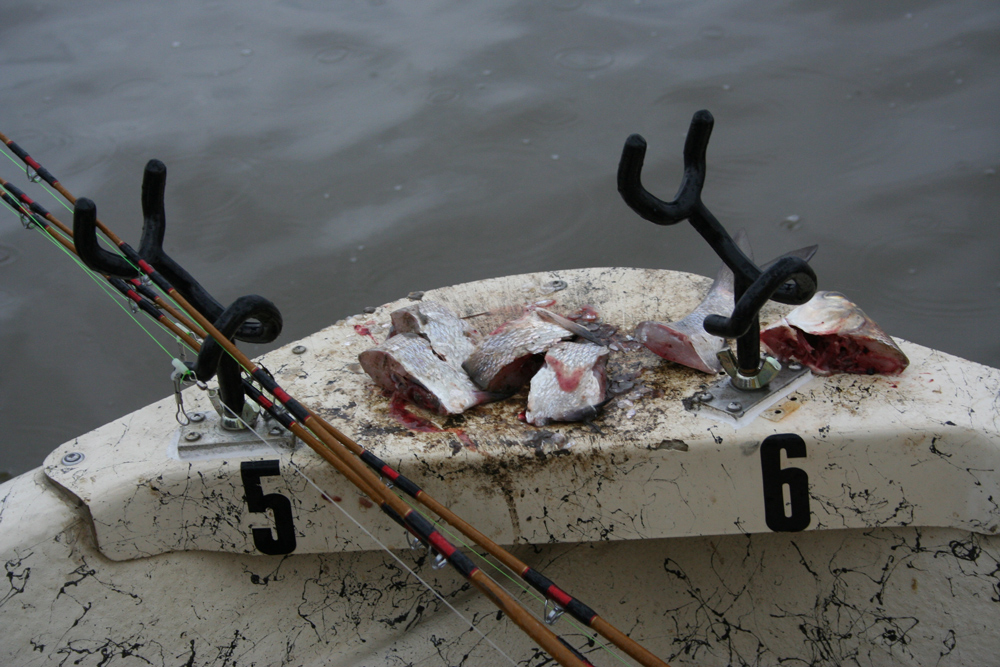Those familiar with Chesapeake Bay fishing know that in every tributary from the Susquehanna River clear down to the Elizabeth, there’s a fish that stays in town and bites right through the winter months. They’re available in huge numbers, chomp on baits readily, and can top 50, 60, or even 80 pounds. On top of all that, smaller specimens are good eating. Yes folks, we’re talking about catfish.

Blue Cats, Channel Catfish, and Flatheads, Oh My!
To target winter cats, you’ll want to look for significant channels or holes. As far as holes go, depths of at least 10 or 15 feet are the minimum, and 25 foot holes or deeper, surrounded by areas of muddy bottoms in the five to 10 foot range, are prime. Snags are a pain to deal with, but catfish love ‘em. So a hole with a tree laying on bottom may cause some lost rigs but will also lead to more bites and bigger fish.
When fishing channels, look for areas that have something that interrupts the current. Again, trees laying on bottom are good, bridge abutments are another good bet, and in many areas large rocks or boulders do the trick. In some rivers a very sharp bend is all it takes. In all cases, try to cast into the area where the current is diverted. Catfish are lazy beasts, and enjoy a spot where they can sit without expending a ton of energy, fighting the moving water.
This is one type of fish that boat, kayak, and shoreline anglers can all get in on more or less equally. The only thing you need to make sure of is that you have sufficient depth within casting range. Remember that catfish do tend to hang deeper during the winter months, and some spots that produced in the summer may not be productive at this time of year.
Catfish Catnip
To get winter cats to bite you’ll want to use a bait that has plenty of stink. Cut herring or menhaden fits the bill perfectly, some catfish sharpies swear by chicken livers, and they’ll also eat big bullhead minnow without hesitation. In Virginia’s tidal rivers, fresh cut gizzard shad is usually considered the prime bait.

Whichever you choose, you’ll want to keep it dead on bottom. You can accomplish this by using a regular top-and-bottom rig, but a leader rigged through an egg sinker works better since it allows you to let the fish eat for a moment or two without feeling any resistance from the lead. Tie up a three or four foot leader of 50 pound test line, with a swivel on one end and a hook on the other. Don’t worry about the thick leader scaring off the fish, because those cats really don’t seem to care either way. “Leader shy” is not a term applied to these species.
Large hooks are the norm when targeting these fish, and many sharpies use 8/0, 10/0, or even 12/0 sizes. One thing everyone agrees on, though, is that circle hooks are the way to go. You’ll want to give the catfish plenty of time to eat the bait, then wait for it to swim off and apply tension on its own, allowing the circle hook to find the corner of its jaw.
Run your main line through the egg sinker, then tie it off to the swivel on the end of the leader. Any 15 to 30 pound-class tackle will work, either spinning or casting as you choose. If you’re in an area where monster blue cats abound, you may want to up-size your gear. Forty or even 50 class gear isn’t out of line, when you may well hook into a fish of 60 or 70 pounds. Remember, however, that those big blues tend to collect mercury in their bodies and in many areas, large specimens aren’t necessarily the best to eat – check local advisories before you keep anything meant for the table. (Most authorities agree that fish of 30 inches or less are fine to eat, though there are a few waterways, such as the Anacostia, where all consumption is discouraged).
There’s some specialized gear you’ll want when dealing with big cats. Toss a pair of thick leather work gloves into the boat so you can hold these slime balls firmly, without getting barbed in the hand. Be very careful during the landing and un-hooking stages, as the barbs on these fish are seriously dangerous. Puncture wounds caused by them often become infected, and are always painful. Make sure you have a pair of needle-nose pliers onboard as well, to assist in getting the hooks out.

The World's Best Catfish Recipe
Okay: You’ve photographed and released the big beast, put a half-dozen eaters into the cooler, and now you’re ready to chow down on mid-winter catfish? Try this recipe. Just make sure you open all the windows, turn on a fan, and pull the batteries out of your smoke alarms, first, because “Banned From The Kitchen” Blackened Catfish will cause quite a stir.
Ingredients (serving size per person):
- One half to one pound catfish fillet.
- One quarter stick of butter
- Two teaspoons chili powder
- One teaspoon each of: Cayenne pepper, Black pepper, Crushed red pepper, Old Bay
- One half teaspoon garlic powder
Put the well-chilled fillets in a plastic zipper-lock bag. Heat the butter in a microwave oven until it’s just melted. Allow it to cool until it’s still liquid, but is not hot. Pour the spices into the butter, and mix thoroughly. Pour the spice-and-butter soup into the plastic bag with the fish, seal it, and shake it. Ensure that the fillets are one-hundred percent coated. Remove them from the bag with a fork, and set them on aluminum foil as the spiced butter hardens. (This should only take a minute or two, if the fillet was completely chilled and the butter was cooled enough. If the butter doesn’t harden, put the fillet back in the refrigerator until it does so.)
Heat an iron skillet over a high heat. Drop a tiny bit of butter onto the skillet to test the surface; when the butter instantly boils and sizzles, the skillet is ready. Drop the fillet onto the hot skillet – and stand back! The butter will immediately start burning and smoking, to the point that well-intentioned neighbors may call the fire department. Allow the fillet to sizzle in place for 90 seconds. Then hold your breath, duck into the cloud, and flip the fillet. Give it an additional 90 seconds to cook on the other side, then remove it from the heat. Your kitchen emissions may have significantly contributed to the greenhouse effect, but Banned From the Kitchen Catfish is worth it.